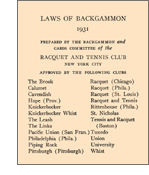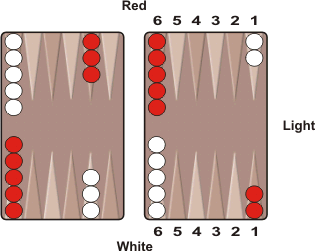![[Backgammon Galore!]](/gif/GaloreButton.gif)
|
|
Backgammon Variants  In the 1920s, the popularity of backgammon greatly increased in North America and Europe. It was during this time that the doubling cube was introduced to backgammon. The doubling cube livened up the game and no doubt contributed to the new interest in the game. In the 1920s, the popularity of backgammon greatly increased in North America and Europe. It was during this time that the doubling cube was introduced to backgammon. The doubling cube livened up the game and no doubt contributed to the new interest in the game.
Among places where backgammon was most popular was New York's Racquet and Tennis Club. In 1931, Wheaton Vaughan, chairman of the club's Card and Backgammon Committee and coauthor of the book Winning Backgammon, decided to undertake the task of preparing laws for the game. He wrote to other interested clubs and asked them to send representatives to meetings. Many clubs in the New York area participated, and others around the country announced their willingness to abide by whatever laws were formulated. The rules prepared by this committee became widely accepted across the United States. These were the first set of rules that incorporated the use of the doubling cube, and they form the basis for the rules of backgammon as it is played around the world today.
LAWS OF BACKGAMMON
|
|
The Brook Calumet Cavendish Hope (Prov.) Knickerbocker Knickerbocker Whist The Leash The Links |
Pacific Union (San Fran.) Philadelphia (Phila.) Piping Rock Pittsburgh (Pittsburgh) Racquet (Chicago) Racquet (Phila.) Racquet (St. Louis) Racquet and Tennis |
Rittenhouse (Phila.) St. Nicholas Tennis and Racquet (Boston) Tuxedo Union University Whist |
-
The Game
- The game of Backgammon is played by two persons.
- Thirty men—fifteen of one color and fifteen of another—are used, and are set up as shown below, on a standard board, of four quarters or tables having six points each.

- For entering and throwing off, the points in both inner tables are considered as numbered from 1 to 6, beginning with the point nearest the light.
- Direction of play is from adversary’s inner table to adversary’s outer table, to player’s outer table, and then to player’s inner (home) table.
- Play of the men is governed by two dice, thrown (cast) from a cup in which the dice are shaken before casting.
- Choice of seats, men, set-up, dice, etc., shall be made by the player winning the opening throw.
The Throws
- For the opening throw each player throws a single die. Every tie requires another opening throw. Whoever throws the higher number wins, and for his first move plays the numbers upon both dice. After that each player in turn throws two dice.
- The dice must be rolled together and come to rest flat (not "cocked") upon the tables at
the player’s right, otherwise they must be thrown again.
- If a throw is made before an adversary’s play is completed, or if either player touches a
die before it has come to rest, the adversary of the offender may require a rethrow.
- The player must leave his dice upon the board until his play is completed. Should he
pick them up or turn them over before the completion of his play, the adversary may declare the play void and require the offender to replace the man or men moved and to throw again.
The Play
- The play of the men consists:
- In moving a man the exact number of points indicated by the number on a die thrown.
- Entering a man, in the adversary’s inner table, on a point corresponding to the number on a die thrown.
- Throwing off (bearing) a man in player’s inner table—when no man is left outside that table or on the bar—from a point corresponding to the number on a die thrown, or as provided in Law 15. Doublets require four plays—if possible—of the die number thrown.
- No play may be made which lands on a point held by two or more of the adversary’s
men.
- When a play lands on a single man (blot) of the adversary’s, such man is hit, and must be lifted and placed on the bar for entry in the player’s inner table.
- A player having a man on the bar may not play until that man has been entered.
- Plays must be made for both dice if possible. Either number may be played first. If only one number can be played, and there is a choice, the higher must be played.
In throwing off, a man may at all times be correctly thrown off from the highest occupied point which is lower than the number indicated by a die. If a number is thrown for an unoccupied point, no man below can be thrown off, for such number, while any man remains on a higher point.
- Whenever a man has been moved correctly and quitted (the player’s hand removed),
that play cannot be changed.
Errors
- If an error has been made in the set-up, either player may correct it prior to the completion of his first play.
- If an error in play has been made, either player may require its correction before a subsequent throw, but not thereafter. The man played in error must be correctly played if possible.
Scoring
- A game is won by the player who first throws off (bears) all of his men.
A Gammon (double game) is won if the adversary has not thrown off a single man. This doubles the count for a single game.
A Backgammon (triple game) is won if the adversary has not thrown off a single man, and has one or more men in the winner’s inner table or upon the bar. This triples the count for a single game.
- DOUBLING GAME. The count is raised:
Automatically—By agreement, each tie of the opening throw may either:
- Double the previous count.
- Add one to the previous count.
Unless an understanding has been reached as to the method and limitation of automatic raises they are not played.
Voluntarily—Either player may offer the first optional double of the previous count. After that the right to double the previous count alternates, being always with the player who has accepted the last double.
In every case, a double may be offered only when it is the player’s turn to play and before he has thrown the dice. A double may be accepted or declined. The refusal of a double terminates the game, and the player refusing loses whatever his count may amount to at that time. Gammons and Backgammons double or triple the last count.
- BY AGREEMENT other methods of scoring may be used, such as:
The Point Game. In this 1 point is scored, by the winner of a game, for each man left in the adversary’s inner table; 2 points are scored for each man left in the adversary’s outer table; 3 points for each man left in the winner’s outer table, and 4 points for each man left in the winner’s inner table or upon the bar.
| Rule Changes Since 1931 | |
|
References
- Walter L. Richard: Complete Backgammon. Includes a section with questions and answers on how to interpret the rules.
- Charles H. Goren: Goren's Modern Backgammon Complete. Includes annotations describing the differences between the 1931 and 1970s rules.
- John Longacre: Backgammon of Today.
- Georges Mabardi: Vanity Fair's Backgammon to Win.
- William H. Walling and William J. Hiss: Backgammon Standards.
![]()
Backgammon Galore : Variants
